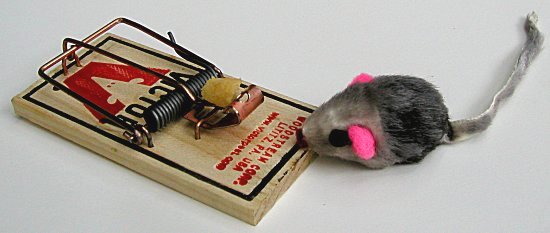Mousetraps and Paperclips
Today, a reflection on moustraps and paperclips. The University of Houston's College of Engineering presents this series about the machines that make our civilization run, and the people whose ingenuity created them.
Two devices were patented in 1899. One was the familiar snap trap for catching mice. The other was a machine for making the ubiquitous Gem paper clip -- the kind you and I use every day.
The odd thing about both patents is that they were among the very first for both devices. Yet each has since been followed by thousands of patents that claim to improve upon it.
Both are compromise solutions to difficult problems. Both are simple, cheap, and easy to use. The other designs go wrong in many ways. An ill-conceived paperclip tears paper, or it fails to keep its grip. Mousetraps have to be at least somewhat clean and merciful in dispatching the mouse -- and few designs are.
All those subsequent patents! Yet, no better all-around exemplar of either invention has been created. There has to be something subtle at play here.
We catch a clue when we look at the Arts and Crafts Movement, which began in England in the latter nineteenth century and soon swept America. The movement had begun as resistance to big industry and the sudden explosion of cheap, factory-made goods.
The arts and crafts people soon spawned the art nouveau school of design, with its leaves and vine-like tendrils. Art nouveau was marked by supple lines -- both graceful and ornate. By 1900, art nouveau had become pretty routine, and the arts and crafts movement had found a place right alongside twentieth-century production.
Countless books-for-boys elaborated the theme. They showed how to build our own radio, our own sled, even our own airplane. These books presumed that we would not only build, but that we'd also elaborate. We were expected to invent as we went along.
Meanwhile, all this creative craftsmanship had picked up a catchphrase. Emerson was widely misquoted as having said, "Build a better mousetrap and the world will beat a path to your door," and the phrase caught our imaginations. The better mousetrap became an idea around which we molded our expectations -- a metaphor for the new fusion of invention with arts and crafts.
Now we would all be inventors in our basement shops. And, basement inventors really did create all sorts of things. The number of patents per year began rocketing upward. Roughly ninety percent of all patents have been issued since 1900.
And building a better mousetrap somehow lies at the root of it. The better mousetrap sounds like doggerel, yet five thousand mousetrap patents have been issued after the definitive one. It's a metaphor of great power, a kind of holy icon of invention. You may take this as far-fetched, but all those after-the-fact mouse-trap patents seem to play the role of a tithe that we pay to the icon.
Something happened at the turn of this century. We all became inventors. And every time I look for cause and effect, I run into the arts and crafts movement -- and I run into mousetraps.
I'm John Lienhard, at the University of Houston, where we're interested in the way inventive minds work.
(Theme music)
For source material, click on the relevant links in the text above.

(photo by John Lienhard)